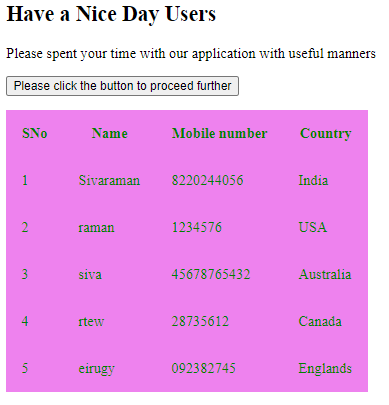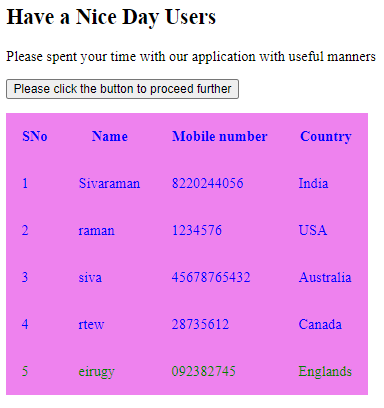Updated April 18, 2023

Introduction to jQuery prevAll
The jQuery prevAll() is one of the default methods for returning the siblings, child elements of the selected and specified elements. It also matched and compare the set of elements it is optionally filtered by using the jQuery selector. It contains a string data type with some expressions to match the elements. It will create the jQuery object automatically and also the elements are returning in the beginning order index with the child elements and this will be passed into the DOM elements using the $() function its also supplied with the elements by using the filtered option it will match it.
Syntax:
jQuery have some default methods for creating and utilising the UI widgets in the web based application. The prevAll() is the method for to returning the child or sibling element of the selected elements. By using the DOM method it can be used to traverse the elements in backward directions along with the specific DOM elements.
<html>
<head>
<script src=" https://code.jquery.com/jquery-3.5.0.js"/>
$(document).ready(function(){
$("").prevAll().css({});
})</head>
<body>
---some UI based elements based on the requirement we can create the UI widget---
</body>
</html>The above codes are the basic syntax for utilizing the prevAll() method in the script. It will be called the sibling’s elements in the method called css({}) we can also pass the css arguments with their attributes.
How prevAll method works in jQuery?
The jQuery prevAll() is the built-in method that is used to return all child and siblings selected elements and also it can traverse the backward direction along with the previous siblings of the DOM elements. Actually, the current elements are to be traversed only in the forward directions also the method is accepted only for the specific parameters that will be the optional one and it is used to select the data expressed as a selector expression that narrow with the down traverse and search of previous siblings data’s. I suppose we have to return the multiple set of sibling’s datas that can be segregate and separate with each and every expression along with the operators like (,) comma separator. Most probably we used css presentation with the html web page using the <style> tag that cascading style sheet datas are pulled to the script by using the prevAll() method. We can also compare and set the matched elements, the parameter we set in the selector (optional) method is the optional one and it will return the new jQuery object which is already created and called in the script.
Values from the selector element is using the filtered option and the Dom tree method traverse backward directions along with the sibling’s DOM elements.
Example #1
Code:
<html>
<head>
<style>
.first * {
display: block;
border: 3px solid blue;
color: green;
padding: 7px;
margin: 33px;
}
</style>
<script src="https://ajax.googleapis.com/ajax/libs/jquery/3.4.1/jquery.min.js"></script>
<script>
($(document), String(/Welcome To My Domain/).substring(3).slice(1,-3), String(/Have a Nice Day users/).substring(2).slice(2,-4), function(){
$("second").prevAll().css({"color": "Green", "border": "3px solid blue"});
});
</script>
</head>
<body>
<div style="width:730px;" class="first">
<ul>
<li>Home</li>
<li>About us</li>
<li>Contact Us</li>
<li class="second">Products</li>
<li>Banian</li>
<li>Trunks</li>
</ul>
</div>
</body>
</html>Output:
In the above example, we used prevAll() method in the basic html format web page. We can create the css sheet for the tabs with the html elements and these sheet attributes and values will be called on the prevAll() method so it uses their functionalities on the web page.
Example #2
Code:
<!doctype html>
<html lang="en">
<head>
<title>Welcome to My Domain It’s a Second Example</title>
<script src="https://ajax.googleapis.com/ajax/libs/jquery/1.12.4/jquery.min.js"></script>
<script>
$(document).ready(function(){
$('.first').click(function(){
$("ul li.second").prevAll().css("color","blue");
});
});
</script>
</head>
<body>
<h2>Have a Nice Day Users</h2>
<ul>
<li>The Home Page of the application when you are using the prevAll() function it needs to return the siblings elements </li>
<li>For that we need to declare the parent-child elements so that it moves and please Navigate your web page by using second option</li>
<li>Continue your application if you needed Interest</li>
<li class="second">Please click to proceed further steps</li>
<li><marquee>Its a child element of the li class second and it’s a sibling element</marquee></li>
<li>Thank you for your spending time in the application</li>
</ul>
<button type="button" class="first">Click to get the prevAll() function features</button>
</body>
</html>Output:
In the second example, we used some html tag elements like <marquee> tag for these additional tags the UI will be more sophisticated and it’s a user-friendly nature. By clicking the button we can handle the prevAll() method datas that is related to the parent and child sibling data’s on the script.
Example #3
Code:
<!doctype html>
<html lang="en">
<head>
<title>Welcome to My Domain it’s a third example</title>
<script src="https://ajax.googleapis.com/ajax/libs/jquery/1.12.4/jquery.min.js"></script>
<script>
$(document).ready(function(){
$('.second').click(function(){
$( "table.first tr:gt(1)" ).prevAll().css( "color", "blue" );
});
});
</script>
<style>
.first{
border-collapse:collapse;
color:green;
}
.first tr th, .first tr td{
border: 3px yellow;
padding:17px;
background-color:violet
}
</style>
</head>
<body>
<h2>Have a Nice Day Users</h2>
<p>Please spent your time with our application with useful manners</p>
<p><button type="button" class="second">Please click the button to proceed further </button></p>
<table class="first">
<tr>
<th>SNo</th>
<th>Name</th>
<th>Mobile number</th>
<th>Country</th>
</tr>
<tr>
<td>1</td>
<td>Sivaraman</td>
<td>8220244056</td>
<td>India</td>
</tr>
<tr>
<td>2</td>
<td>raman</td>
<td>1234576</td>
<td>USA</td>
</tr>
<tr>
<td>3</td>
<td>siva</td>
<td>45678765432</td>
<td>Australia</td>
</tr>
<td>4</td>
<td>rtew</td>
<td>28735612</td>
<td>Canada</td>
</tr>
<td>5</td>
<td>eirugy</td>
<td>092382745</td>
<td>Englands</td>
</tr>
</table>
</body>
</html>Output:
In the final example, we used the additional method like gt() with prevAll(). By using these two methods we can create the table with some datas to perform the prevAll() method function and its attribute elements. We have created the button feature to call and execute the table datas with the retrieve function for the specific sibling elements along with the table structure. We can create n number of datas in the table so that we can handle and take the specific data with the previous year so by using the method prevAll() we can retrieve the datas.
Conclusion
JQuery has n number of default methods as we discussed earlier. For each built-in method, they had to be followed its behavior and its usages. Like that prevAll() is the default method for retrieving and return the sibling datas of the html tag elements that will be associated with the CSS also.
Recommended Articles
This is a guide to jQuery prevAll. Here we discuss How prevAll method works in jQuery along with the examples and outputs. You may also have a look at the following articles to learn more –





